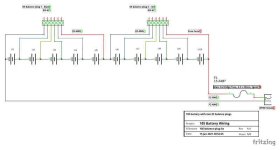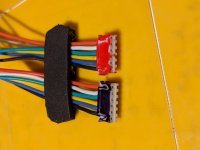pickworthi
100 W
I've attached a diagram showing the wiring of a 10S battery I have built. The charging BMS will be me and a 4010DUO charger.
Discharge short protection is via 15 amp fuse - which is the maximum expected load through the e-bike motor controller (UK regs limited).
My question is about protecting the balance plugs against accidental short circuit. There is no mechanical protection available, since the plugs are identical. I have painted one black and one red, so I can tell which is which when the case is closed. However, there is always a risk that I'll plug them onto the balance board the wrong way round, at which point the red wire on plug 2 and the black wire on plug 1 create a dead short at battery voltage.
While this would probably melt the 22 AWG balance wires, that seems uncontrolled, and hence dangerous (possible runaway short if other balance cables melt and fuse together).
A solution I can think of is to place a fuse by the label "fuse here?" in the balance plug 2 red wire. A fast 2.5 amp fuse should allow the 4020DUO maximum balance current for example, and blow before the balance wires are damaged. Fuse would have to be rated for battery voltage.
I am assuming that the remaining balance connections in this scenario are OK, since there is no short circuit route between them.
Is this a sensible solution? I'm a bit concerned that the added resistance on that one balance wire might interfere with the balance process - but maybe the 4010DUO is smart enough to deal with that?
I'd really appreciate any feedback on this, thanks.

Discharge short protection is via 15 amp fuse - which is the maximum expected load through the e-bike motor controller (UK regs limited).
My question is about protecting the balance plugs against accidental short circuit. There is no mechanical protection available, since the plugs are identical. I have painted one black and one red, so I can tell which is which when the case is closed. However, there is always a risk that I'll plug them onto the balance board the wrong way round, at which point the red wire on plug 2 and the black wire on plug 1 create a dead short at battery voltage.
While this would probably melt the 22 AWG balance wires, that seems uncontrolled, and hence dangerous (possible runaway short if other balance cables melt and fuse together).
A solution I can think of is to place a fuse by the label "fuse here?" in the balance plug 2 red wire. A fast 2.5 amp fuse should allow the 4020DUO maximum balance current for example, and blow before the balance wires are damaged. Fuse would have to be rated for battery voltage.
I am assuming that the remaining balance connections in this scenario are OK, since there is no short circuit route between them.
Is this a sensible solution? I'm a bit concerned that the added resistance on that one balance wire might interfere with the balance process - but maybe the 4010DUO is smart enough to deal with that?
I'd really appreciate any feedback on this, thanks.



